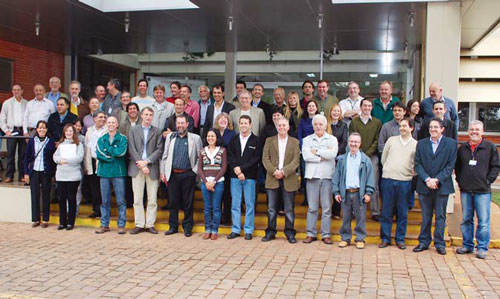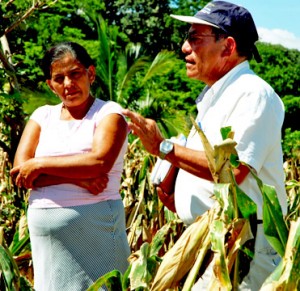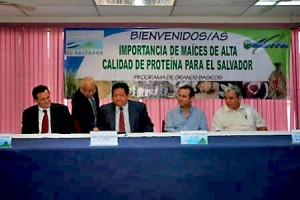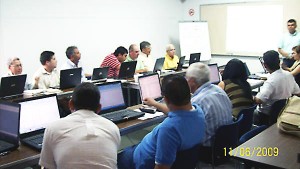Varieties of QPM released
Two new quality protein maize (QPM) varieties, designed to thrive in the tropical lowland coffee production zones of southwest Colombia, were released on 14 April 2010. CIMMYT-Mexico developed these two varieties—yellow maize FNC 31AC and white maize FNC 32AC—and the Fundación para la Investigación y Desarrollo Agrícola (FIDAR) evaluated them, under the supervision of Luis Narro of CIMMYT-Colombia. More than 150 people attended the launch event, held at the fields of the International Center for Tropical Agriculture (CIAT) in Palmira, a city in the Cauca Valley, Colombia.
The two varieties yield five tons per hectare, similar to normal maize, but have more tryptophan (0.08% compared to 0.05% of normal maize). Tryptophan is one of two amino acids required for protein synthesis in humans and swine livestock. The release of these QPM varieties is part of the Agrosalud Project, which aims to develop and disseminate biofortified crops, including maize, bean, rice, and sweet potato, and was the result of collaboration with CIMMYT, CIAT, and FIDAR. The National Federation of Colombian Coffee Growers (FENALCE) will take charge of seed production and distribution.
Visits and collaborations at CIMMYT-Colombia
The Global Maize Program’s new director, B.M. Prasanna, continues his travels to CIMMYT’s extensive and wide-spread maize offices. His most recent stop was to CIMMYT-Colombia where from 26-28 April he met with CIMMYTColombia staff and coordinated collaborative activities between CIMMYT and CIAT for Latin America, Asia, and Africa.
Included among other activities was a visit to one of the research stations of the Federación de Cafeteros de Colombia. The experimental station, Centro Nacional de Investigaciones de Café (CENICAFE) La Catalina, is a key area for maize-coffee trails. The director of the station, Carlos Gonzalo Mejía, showed Prasanna (accompanied by Félix San Vicente, maize breeder, and Reymunda Labuguen, program administrator) the fields where since 2002 CIMMYT has collaborated with FEDERECAFE (the National Federation of Colombian Coffee Growers) and FENALCE to sow maize among coffee trees. FENALCE researcher Argemiro Moreno highlighted the benefits of this crop combination, pointing out that maize yields in coffee production zones are high. This year, for example, experimental maize fields at La Catalina yielded 18 tons per hectare.
Agronomic management was another topic of conversation. FENALCE researcher Argemiro Moreno showed staff how to use GreenSeeker, a tool that allows farmers to apply the proper amount of nitrogen to their fields, which he learned about during a recent visit to CIMMYT’s Norman E. Borlaug Experimental Station, in Ciudad Obregón, Sonora, Mexico.
Later, a meeting with Rubén Echeverría, director general of CIAT, led to the conclusion that CIMMYT and CIAT can and should increase collaboration for key areas in Latin America. Highlighted initiatives included 1) improving efficiency in the maize-bean-cattle production systems, 2) efficient utilization of new tools and methods to improve and expedite plant breeding and selection, 3) evaluation and promotion of precision agriculture technologies, and 4) capacity building with students and farmers for faster, effective technology adoption.
To follow-up on these identified issues, the visitor group toured CIAT facilities and met with some of the researchers involved in the emphasized areas, including Michael Peters, tropical forages program leader, Idupulapati M. Rao, physiology and plant nutrition, and Steve Beebe, bean breeder.
Fieldbook course
Two CIMMYT-Colombia team members led a course on Fieldbook during 13-14 May 2010. The course attracted 10 participants, including representatives from two local seed companies, Semivalle and Sem-Latam S.A, and agronomy students from the Corporación Universitaria Santa Rosa de Cabal, Risaralda, Colombia.
Yacenia Morillo, head of Semivalle’s basic research, said that Semivalle will embrace this new knowledge and software, and thanked course organizers Néstor Romero and Alba Lucía for their hard work. Counting this event, CIMMYT has now trained nearly 100 Latin American researchers from public and private organizations in Bolivia, Colombia, Ecuador, and Peru.

 It was unusually hot for the rainy season, but the torrid sun did not dampen farmers’ enthusiasm on the afternoon of 02 September 2009. “This is a variety that yields well, even if we don’t put lots of fertilizer on it, and it has a sweet taste and mills well,” said Francisca Lilian Melgar. Along with 24 other farmers at Lomas de Santiago, El Salvador, she has joined her plot with others to form a communal “mega-plot” of about 25 hectares to test-grow the quality protein maize (QPM) hybrid ‘Oro Blanco’ (White Gold).
It was unusually hot for the rainy season, but the torrid sun did not dampen farmers’ enthusiasm on the afternoon of 02 September 2009. “This is a variety that yields well, even if we don’t put lots of fertilizer on it, and it has a sweet taste and mills well,” said Francisca Lilian Melgar. Along with 24 other farmers at Lomas de Santiago, El Salvador, she has joined her plot with others to form a communal “mega-plot” of about 25 hectares to test-grow the quality protein maize (QPM) hybrid ‘Oro Blanco’ (White Gold). Hours earlier that day, many of the same specialists, along with staff of the Health and Education ministries and representatives of farmer associations, had gathered in the headquarters of El Salvador’s Ministry of Agriculture and Livestock in San Salvador to attend presentations and take part in discussions on the importance of QPM. The event was covered by leading national TV and radio stations, and included presentations by Scott Ferguson, CIMMYT deputy director general for Support Services; Kevin Pixley, associate director of CIMMYT’s Global Maize Program; and Hugo Córdova, retired CIMMYT maize breeder and distinguished scientist. Among other things, presenters reported on achievements of AgroSalud. “In the last five years, we’ve achieved annual increases of 250 kilograms per hectare in the yields of QPM hybrids,” said Córdova, a Salvadoran native. “Because the parent lines were selected under stress conditions, these hybrids perform well in all settings.”
Hours earlier that day, many of the same specialists, along with staff of the Health and Education ministries and representatives of farmer associations, had gathered in the headquarters of El Salvador’s Ministry of Agriculture and Livestock in San Salvador to attend presentations and take part in discussions on the importance of QPM. The event was covered by leading national TV and radio stations, and included presentations by Scott Ferguson, CIMMYT deputy director general for Support Services; Kevin Pixley, associate director of CIMMYT’s Global Maize Program; and Hugo Córdova, retired CIMMYT maize breeder and distinguished scientist. Among other things, presenters reported on achievements of AgroSalud. “In the last five years, we’ve achieved annual increases of 250 kilograms per hectare in the yields of QPM hybrids,” said Córdova, a Salvadoran native. “Because the parent lines were selected under stress conditions, these hybrids perform well in all settings.” About 20 scientists from
About 20 scientists from